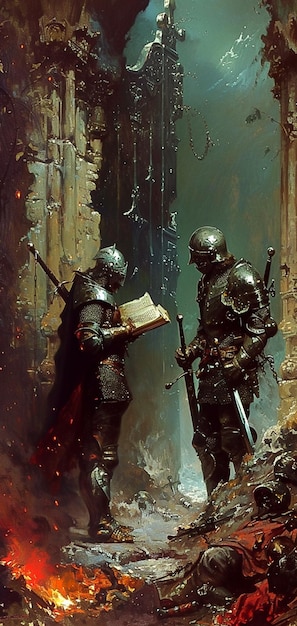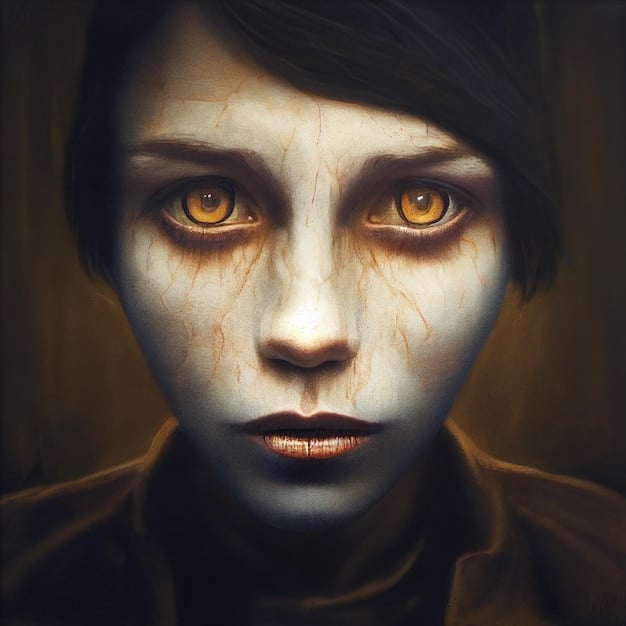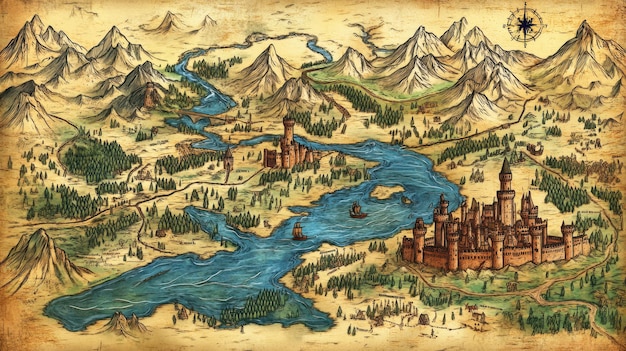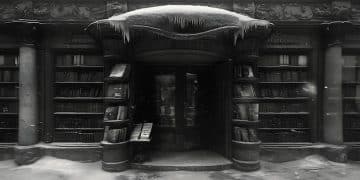Grimdark Fantasy’s Dominance: Why It’s So Popular in the US

Grimdark fantasy’s dominance in the US stems from its realistic portrayal of a morally gray world, resonating with readers seeking narratives that challenge traditional heroic fantasy tropes and explore the darker aspects of human nature and society.
Grimdark fantasy’s dominance: Understanding the popularity of grimdark fantasy novels in the US has surged in recent years, captivating readers with its morally ambiguous characters, brutal realism, and rejection of traditional heroic narratives. But what exactly is it about this gritty subgenre that has resonated so strongly with American audiences?
What is Grimdark Fantasy?
Grimdark fantasy is a subgenre of fantasy that deviates sharply from the idealized worlds and heroic characters often found in traditional fantasy. It embraces moral ambiguity, portraying a world where good and evil are not always easily distinguishable, and the consequences of actions are often harsh and unforgiving.
In essence, grimdark presents a world that feels more real, where characters make difficult choices with lasting repercussions. It’s a reaction against the lighter, more optimistic fantasy narratives that have dominated the genre for decades.

Key Characteristics of Grimdark
So, what are the hallmarks of grimdark fantasy that set it apart from other fantasy subgenres?
- Moral Ambiguity: Characters are rarely purely good or evil. They operate in shades of gray, making difficult choices to survive or achieve their goals.
- Brutal Realism: Violence and death are commonplace, and the consequences of war and conflict are depicted in graphic detail.
- Anti-Heroes: Protagonists are often flawed and morally questionable, driven by self-interest rather than altruism.
- Pessimistic Tone: The overall tone is often bleak and cynical, with little hope for lasting happiness or redemption.
Grimdark doesn’t shy away from exploring the darker aspects of human nature, and societies often reflect the flaws and corruption found in our own world.
In summary, grimdark fantasy offers a stark and unflinching view of a world devoid of easy answers and clear-cut heroes.
The Appeal of Grimdark: Why US Readers Are Hooked
What makes grimdark fantasy so appealing to US readers? Is it simply a fascination with darkness, or is there something more profound at play?
Several factors contribute to the subgenre’s popularity, reflecting a shift in reader preferences and a desire for more complex and challenging narratives.
Challenging Traditional Fantasy Tropes
Many readers have grown tired of the predictable tropes of traditional fantasy, such as the chosen one narrative or the clear-cut battle between good and evil. Grimdark offers a refreshing alternative, subverting these tropes and presenting a more realistic and morally complex world.
It questions the idea of inherent goodness and challenges readers to reconsider their assumptions about heroism and villainy.
Relatability Through Flawed Characters
While grimdark characters may be morally ambiguous, they are often more relatable than the idealized heroes of traditional fantasy. Their flaws and struggles mirror our own, making them feel more human and authentic.
Readers can connect with their imperfections and empathize with the difficult choices they face.

Reflection of Modern Disillusionment
Grimdark’s cynicism and pessimism resonate with a sense of disillusionment that is prevalent in modern society. In a world filled with political division, economic uncertainty, and environmental concerns, many people find themselves drawn to narratives that reflect their anxieties and frustrations.
Grimdark provides a form of escapism that acknowledges the darkness and complexities of the real world.
In conclusion, the appeal of grimdark fantasy lies in its ability to challenge conventions, offer relatable characters, and reflect the anxieties of modern life.
Notable Grimdark Series and Authors
The grimdark fantasy landscape is populated with numerous authors and series that have captivated readers with their gritty realism and morally complex characters. Here are a few notable examples:
These authors and their works represent the pinnacle of the grimdark fantasy genre, showcasing its unique blend of darkness, realism, and moral ambiguity.
Joe Abercrombie: The First Law Trilogy
Joe Abercrombie is one of the most prominent voices in grimdark fantasy. His *First Law* trilogy is renowned for its flawed characters, brutal action, and sardonic wit.
- The Blade Itself: Introduces a cast of morally ambiguous characters, including a torturer, a disgraced nobleman, and a barbarian warrior.
- Before They Are Hanged: Continues the story with a focus on war and political intrigue, further exploring the complexities of the characters.
- Last Argument of Kings: Concludes the trilogy with a climactic battle and a resolution that emphasizes the futility of conflict.
Abercrombie’s work is characterized by its unflinching portrayal of violence and its exploration of the human cost of war.
George R.R. Martin: A Song of Ice and Fire
While often categorized as epic fantasy, George R.R. Martin’s *A Song of Ice and Fire* series incorporates many elements of grimdark, particularly in its realistic portrayal of power struggles and its willingness to kill off major characters.
- The series is known for its complex characters, intricate plot, and shocking twists.
- The political landscape is treacherous, with alliances shifting and betrayals commonplace.
- The series explores themes of power, ambition, and the corrupting influence of violence.
Martin’s work has had a significant impact on the fantasy genre, influencing many subsequent grimdark authors.
The grimdark genre is defined by its masterful authors and series that portray realistic and morally ambiguous characters captivating a wide audience.
The Influence of Grimdark on Pop Culture
Grimdark fantasy’s influence extends beyond the realm of literature, permeating various aspects of pop culture. Its impact can be seen in video games, television shows, and even other fantasy subgenres.
The genre’s themes of moral ambiguity, brutal realism, and anti-heroism have resonated with audiences, shaping the way stories are told and characters are portrayed.
Video Games
Several video games have embraced the grimdark aesthetic, offering players immersive experiences in morally challenging worlds. Games like *The Witcher* series and *Dark Souls* are known for their gritty realism, difficult choices, and bleak atmosphere.
These games often feature complex narratives with multiple endings, reflecting the ambiguity of grimdark fantasy.
Television
Television shows like *Game of Thrones* (based on *A Song of Ice and Fire*) have brought grimdark themes to a wider audience. The show’s willingness to kill off major characters and its realistic portrayal of violence have set it apart from other fantasy series.
The success of *Game of Thrones* has paved the way for other grimdark adaptations, demonstrating the genre’s appeal to a mainstream audience.
By expanding to new media formats, grimdark themes have been able to successfully spread to influence other genres and stories.
Criticisms of Grimdark Fantasy
Despite its popularity, grimdark fantasy has also faced criticism. Some readers find its unrelenting darkness and moral depravity to be excessive or gratuitous.
Critics argue that the genre can be nihilistic and devoid of hope, offering little in the way of positive messages or uplifting themes.
Overreliance on Violence and Shock Value
One common criticism is that grimdark often relies too heavily on violence and shock value, sacrificing character development and meaningful storytelling in the process. Some critics argue that the genre can become desensitizing, normalizing violence and dehumanizing characters.
The focus on brutality can overshadow other important aspects of the narrative, such as plot, characterization, and thematic depth.
Lack of Hope and Redemption
Another criticism is that grimdark often lacks hope and redemption. The constant focus on darkness and despair can leave readers feeling emotionally drained and pessimistic.
Critics argue that the genre needs to offer some glimmer of hope or possibility for change, even in the darkest of circumstances.
Even with the criticisms that grimdark fantasy receives, it still retains popularity and readership amongst its audience.
The Future of Grimdark: Evolution or Stagnation?
What does the future hold for grimdark fantasy? Will the genre continue to evolve, or will it stagnate and become repetitive?
The answer likely lies in the ability of authors to innovate and push the boundaries of the genre, while avoiding the pitfalls of excessive darkness and nihilism.
Exploring New Themes and Perspectives
One way for grimdark to evolve is to explore new themes and perspectives. Authors can delve into the psychological effects of violence, the complexities of trauma, and the challenges of rebuilding after conflict.
By focusing on the human impact of grimdark events, authors can create more meaningful and resonant narratives.
The expansion of stories can create greater understanding of the stories.
Finding Hope in the Darkness
While grimdark is known for its darkness, it doesn’t have to be devoid of hope. Authors can explore the possibility of redemption, the power of human connection, and the enduring strength of the human spirit.
By finding moments of light in the darkness, authors can create narratives that are both challenging and ultimately uplifting.
Grimdark is bound to change as society changes and technology improves, which will lead to new themes and perspectives.
| Key Point | Brief Description |
|---|---|
| ⚔️ Moral Ambiguity | Characters often operate in shades of gray rather than being purely good or evil. |
| 🛡️ Brutal Realism | Violence and harsh consequences are common, reflecting a war-torn world. |
| 💔 Anti-Heroes | Protagonists are flawed, driven by self-interest instead of pure altruism. |
| 🌑 Pessimistic Tone | Stories generally have a bleak and cynical overall tone with limited hope. |
Frequently Asked Questions
▼
Grimdark fantasy is defined by its morally ambiguous characters, brutal realism, and generally pessimistic tone that shies away from traditional heroic narratives.
▼
US readers are drawn to grimdark’s complex, relatable characters and its reflection of modern disillusionment, offering a stark contrast to typical fantasy tropes.
▼
Prominent grimdark authors include Joe Abercrombie, known for “The First Law” trilogy, and George R.R. Martin, author of “A Song of Ice and Fire.”
▼
Grimdark themes have been adopted by video games such as “The Witcher” and adapted into television series like “Game of Thrones,” influencing the portrayal of darker narratives.
▼
Criticisms of grimdark include its overreliance on violence and shock value, as well as its general lack of hope and redemptive themes, potentially leading to emotional drain in readers.
Conclusion
In conclusion, grimdark fantasy’s dominance: Understanding the popularity of grimdark fantasy novels in the US continues to grow because of its ability to reflect the realities in the world, creating complex characters that represent both the good and the bad in society.





